These poor man’s burnt ends pack maximum bark and smoke flavor.
By cubing the chuck roast before it goes on the smoker every side gets seasoned, smoked, and caramelized, then the cubes are wrapped with butter and honey for tenderness and glazed with barbecue sauce.
The result? Juicy, bite-sized burnt ends that rival brisket in less time, and for a whole lot less money.
One reader, Carrie, commented: “Super easy and delicious way to use a chuck roast! It requires little prep and minimal work but tastes fantastic! It pairs well with Mac and cheese. We will definitely make it again in the future!!. ★★★★★“
Another reader, Chad, commented: “Wow!! Just made these today. Man were these tasty. I will DEFINITELY be making these again! Thanks for sharing! ★★★★★“
Poor man’s burnt ends vs. brisket burnt ends
Traditional burnt ends come from the point end of a brisket. That section is loaded with fat and collagen, which takes a long cook to render fully, but when it does, you get the most tender, flavorful bites in barbecue.
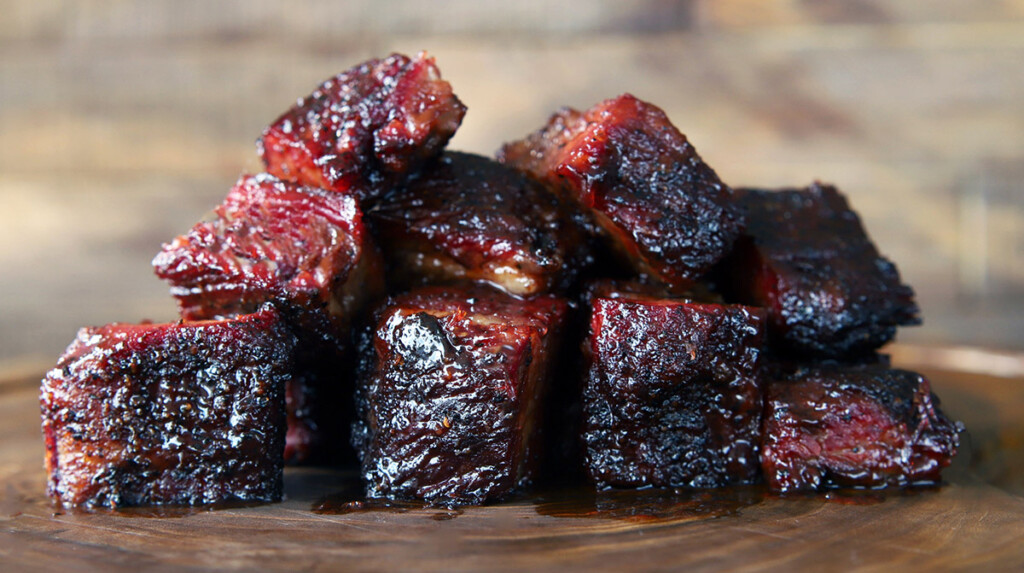
Brisket burnt ends get a slight edge in tenderness.
The downside? Brisket is a huge cut, often 10–20 pounds, and it can easily run over $100. That’s why many pitmasters turn to chuck roast as a budget-friendly alternative. At three to five pounds, it’s easier to manage, cooks faster, and costs a fraction of a whole brisket.
A brisket is a large cut of meat and can be very expensive. That’s why Chuck is a great alternative if you want to try burnt ends on a budget.

Chuck is also a good option for a ‘practice’ run before trying a whole brisket.
Chuck comes from the shoulder area of the cow, right above the brisket. It has a great beefy flavor, although it can be tough because it is a heavily exercised muscle.
Do brisket burnt ends have the edge on richness? Absolutely, the brisket point’s fat content can’t be matched. But smoked chuck still gives you that same barky, saucy burnt end experience. In fact, most people at the table won’t know the difference unless you tell them.
You can smoke chuck like a brisket and slice it, make smoked pulled beef, which is great for sandwiches, or cube it up for burnt ends like we do in this recipe.
Why Are They Called “Poor Man’s” Burnt Ends?
One of the most predictable reactions when this recipe hits social media is a wave of comments pointing out that brisket costs less per pound than chuck.
Brisket can be the cheaper cut, depending on where you live and shop.
So why the name? It’s less about the pound-for-pound price and more about size and availability. A whole brisket usually runs 10–20 pounds and often costs well over $100. By comparison, a chuck roast is three to five pounds, easier to find, and much more manageable for a weeknight or small gathering.
That’s why the “poor man’s” name has stuck. Chuck lets you use essentially the same low-and-slow technique, but on a smaller, more affordable scale. It’s perfect if you don’t want to deal with leftovers filling your freezer or want to practice without committing to a full brisket.
Should you cube before smoking, or after?
If you’ve made traditional brisket burnt ends before, you’ll know that the point is usually smoked whole, and the meat is not cubed until the end of the process.
My method for poor man’s burnt ends flips this approach. Both methods have their pros and cons:
- Smoke whole and cube at the end – More traditional, helps lock in moisture and can give slightly better tenderness, especially with leaner cuts
- Cubed before smoking (my method) – Cutting into 1.5-2″ cubes before smoking means every side of each cube gets seasoning and smoke. You build more bark, and the cook time is shorter. The only risk is dryness if the cubes are cut too small, so don’t go under an inch.
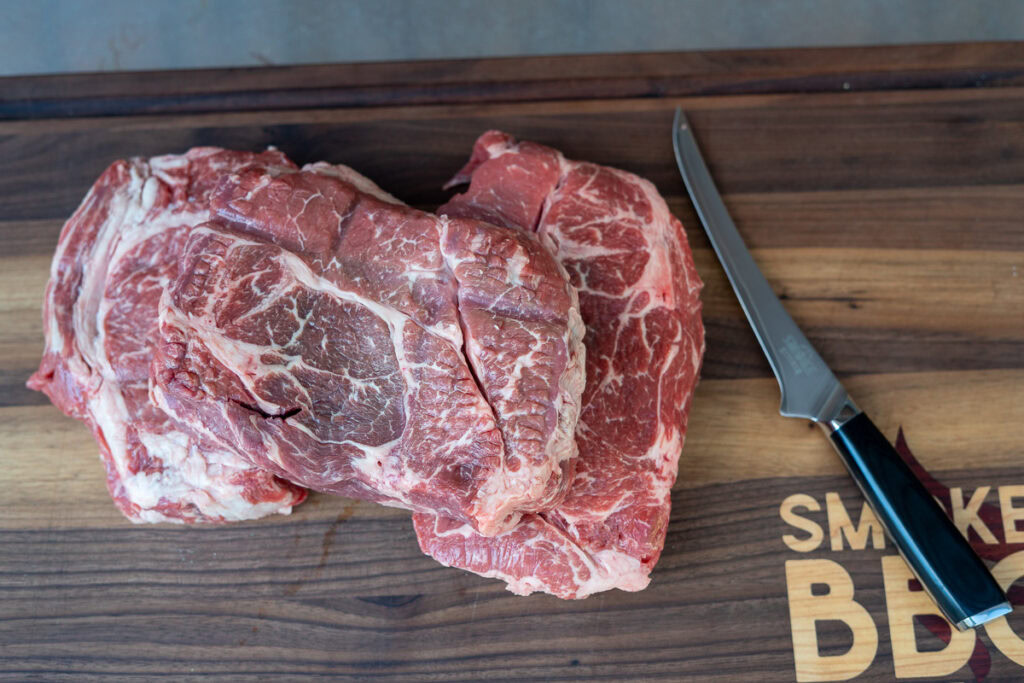
If you want to stick closer to tradition, smoke the roast whole and cube it at the end. If you want maximum bark and flavor, cube it before cooking.
Ingredients for poor man’s burnt ends
- Chuck roast: Look for roasts with even thickness and good marbling.
- Seasoning (SPG base): Salt, pepper, and garlic powder are the backbone of this recipe. I like to add onion powder and smoked paprika for depth and color.
- Binder (optional): A light smear of yellow mustard or oil helps seasoning stick, but isn’t essential.
- Spritz liquid: A 50:50 mix of beef broth and water keeps the cubes moist and helps the bark set. You can swap in apple juice for a touch of sweetness or use beer.
- Wrap additions: I use butter and honey in the wrap to boosts tenderness and adds a subtle glaze without drowning the bark. Some pitmasters mix BBQ sauce with beef broth here, but I prefer to sauce at the end for a stickier finish.
- BBQ sauce: Choose your favorite. Thicker sauces work well for tacking up on the smoker, while thinner sauces soak in more.
How to make poor man’s burnt ends
1. Cut the chuck into cubes
Start by slicing your chuck roast into 1.5-2″ cubes. I aim for just under two inches, as smaller cubes can dry out.
You want the cubes to be as even as possible so they cook at the same time.
But don’t stress if you end up with a few odd-shaped pieces, they make great snacks for the chef.
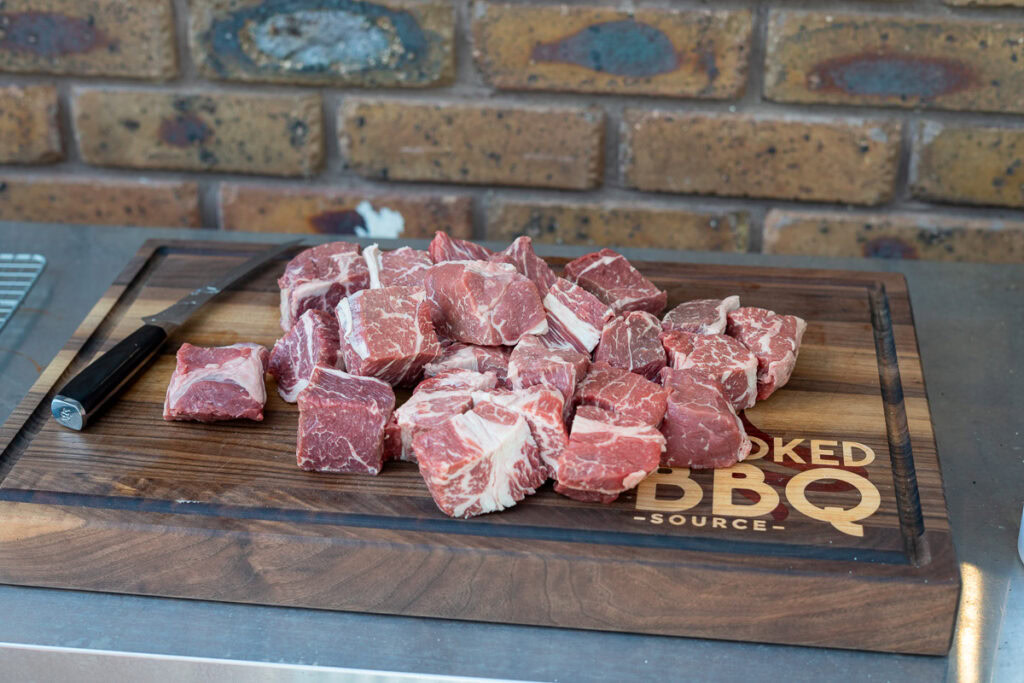
Make sure the cubes are the same size for an even cook.
2. Season the cubes
Any good beef seasoning starts with kosher salt and freshly ground black pepper. I rounded that out with garlic, onion granules, and smoked paprika.
You could go straight with SPG seasoning or use SPG and then hit them with a layer of your favorite store-bought BBQ rub.
Beef can take quite a bit of rub, so don’t hold back!
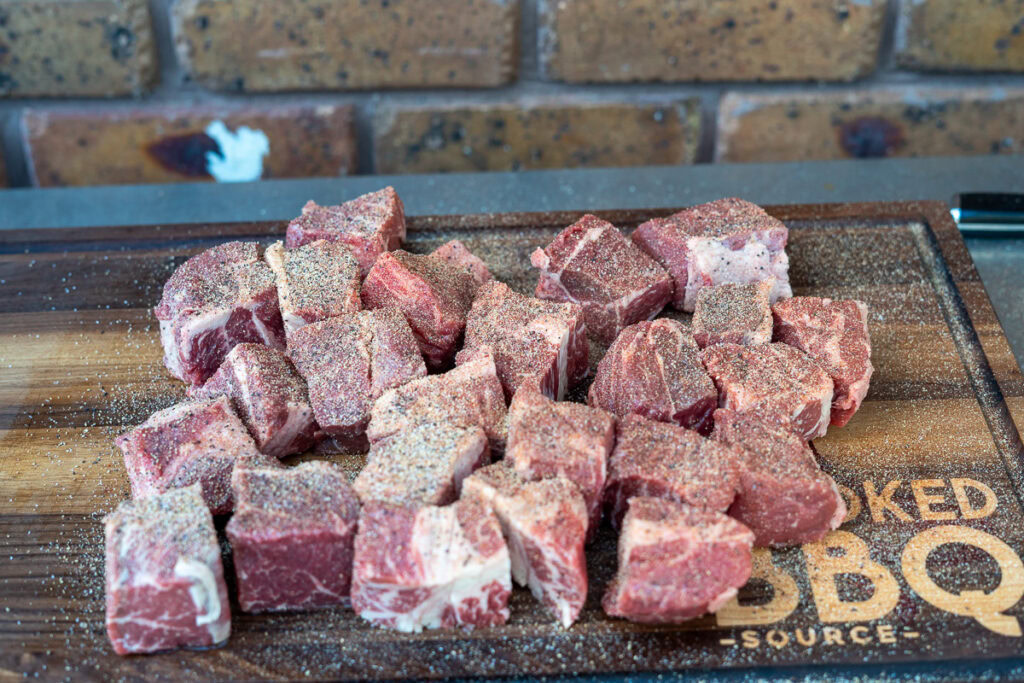
You can add an oil or mustard binder if you prefer, but for this cook, I just seasoned them regularly.
When smoking small things like burnt ends I like using a wire rack so I can quickly take them off the smoker.
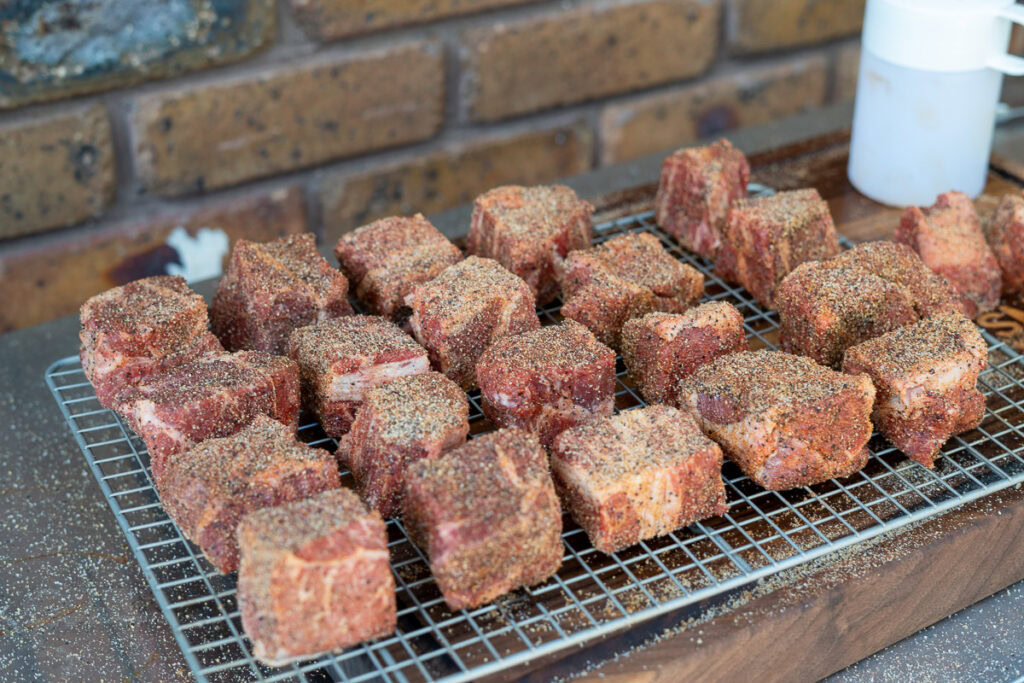
3. Fire up your smoker
You can use any smoker you want for this cook. I fired up my Oklahoma Joe’s Bronco Pro and added three chunks of apple wood. Once the temperature stabilized around 250°F and the smoke came out thin and blue, I put the chuck cubes on.
Make sure the cubes of chuck are spread out evenly on your grill grate with space around them for smoke to penetrade. Although I did not do it here, having a water pan underneath the grate to catch the drippings and to help deflect the heat is a good idea.
This is also a good time to apply extra seasoning to your burnt ends if there are any spots that need BBQ rub.
4. Spritz after an hour on the smoker
After an hour of cooking, spray the burnt ends with a 50-50 mix of water and beef broth.
This will keep the chuck moist and also help with the bark formation. Some people say that spritzing also helps the smoke to stick to the meat and gives a better smoke ring.
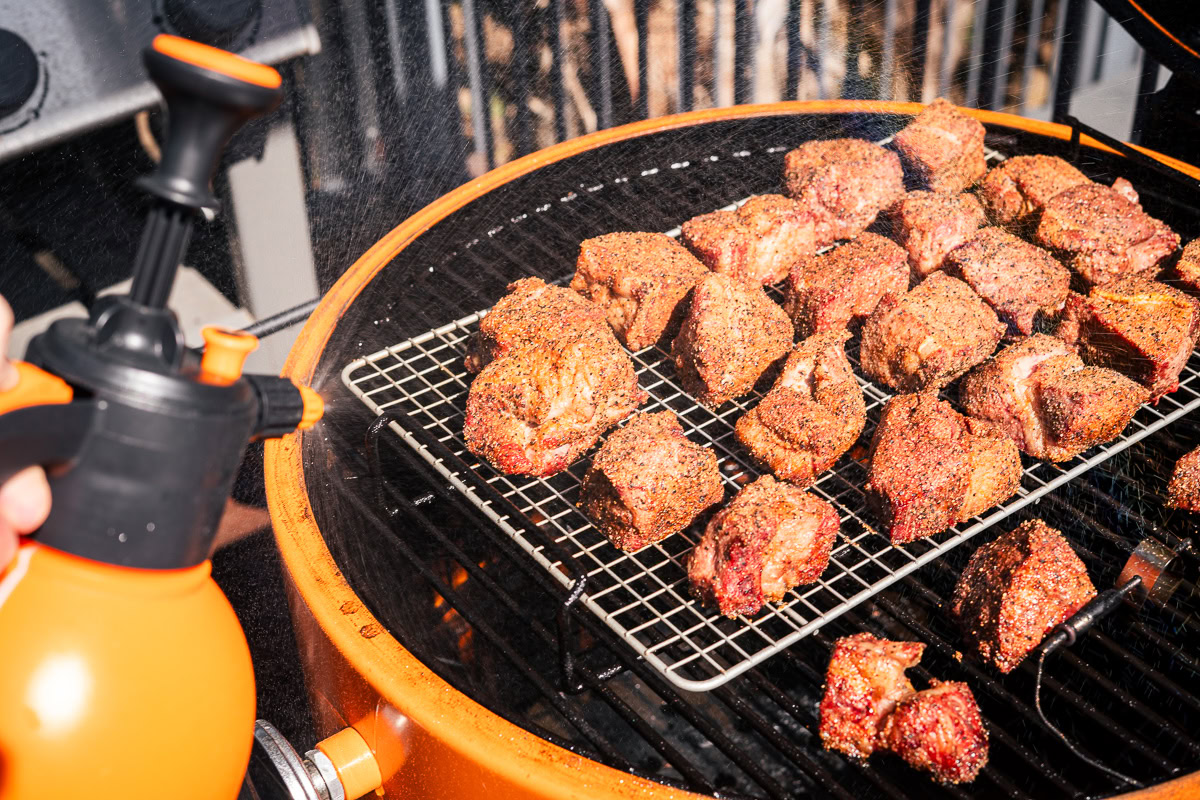
After you have done your initial spritz, spray every 30-45 minutes or when you see the meat starting to dry out.
From Our Shop
Smoke Kitchen BBQ Sprayer
Keep your barbecue nice and moist with this 68 OZ pressurized spritz bottle.
Pros:
- Control spray from a fine mist to a solid stream
SHOP NOW
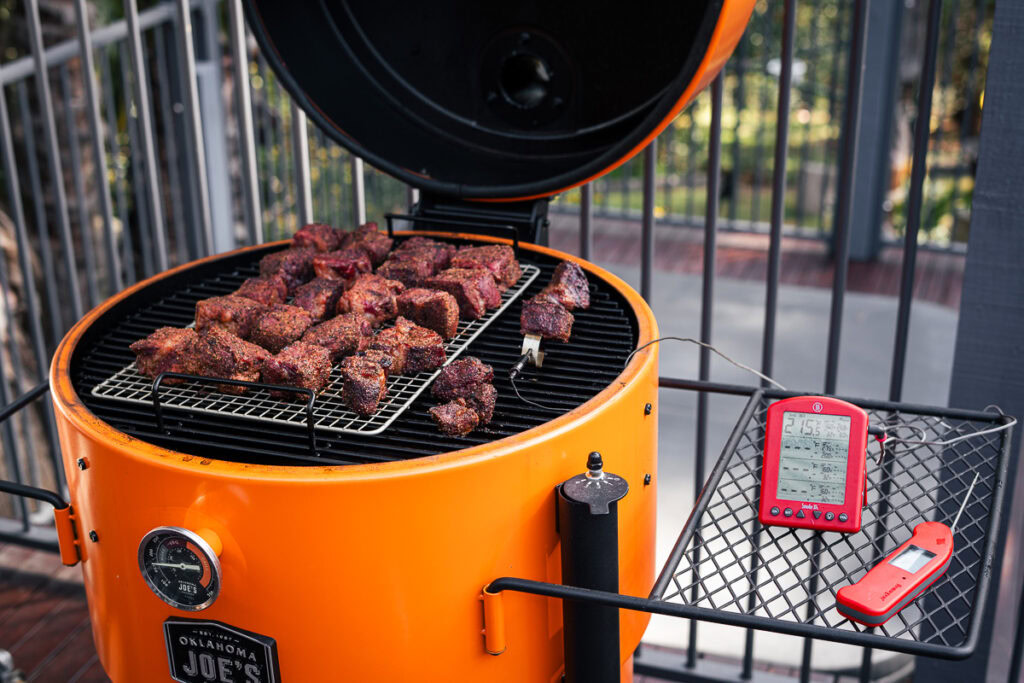
5. After 3 hours the burnt ends are ready to wrap
After smoking for around 3 hours your chuck roast will be ready to wrap. You’re aiming for an internal temperature of 150-175°F, although I prefer to go off the bark rather than a certain internal temp.
The chuck cubes should have a good bark and be much darker in color, especially if you decided to smoke with a stronger smoking wood like hickory.
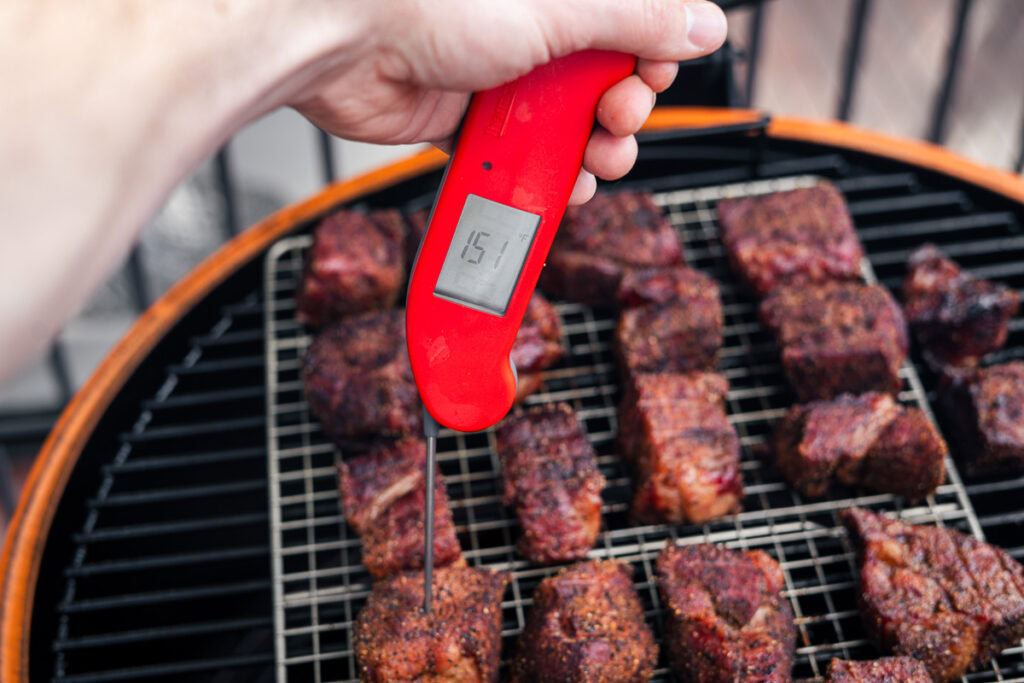
My preference for wrapping burnt ends is an aluminum pan, as it does the best job of containing your wrap ingredients.
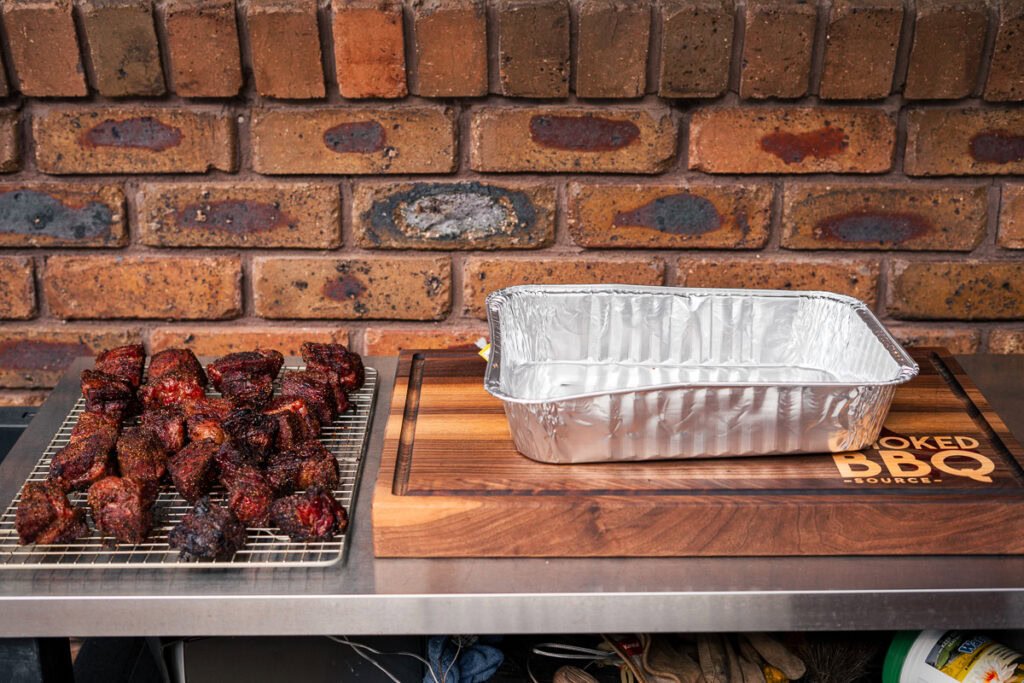
Get the burnt ends off the smoker and into the tray, or two layers of heavy-duty aluminum foil. You can go a few different directions with what you wrap with.
- Honey & Butter – What I went with for this recipe, adds just a touch of sweetness without too much liquid to ruin the bark.
- Beef Broth – More savory, helps braise the meat for more tender burnt ends but can damage the bark.
- BBQ Sauce – I prefer adding at the end, but you can add it here by itself or mixing with either the honey and butter or broth option.
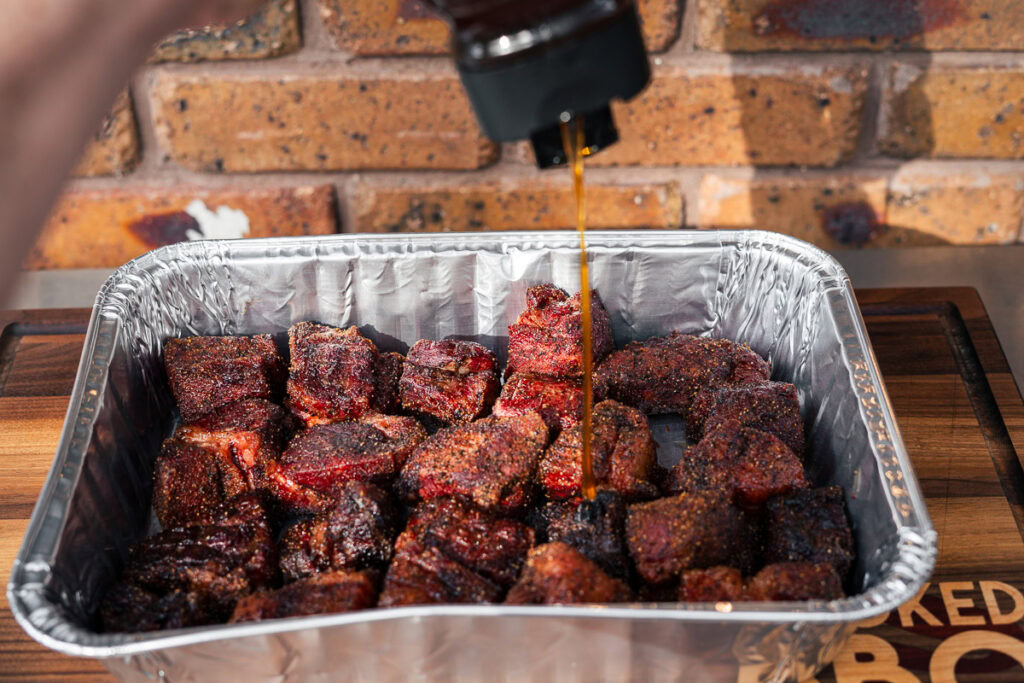

After you have wrapped the chuck roast, place it back on your smoker. To speed things up, you can bump the temperature up to 300°F.
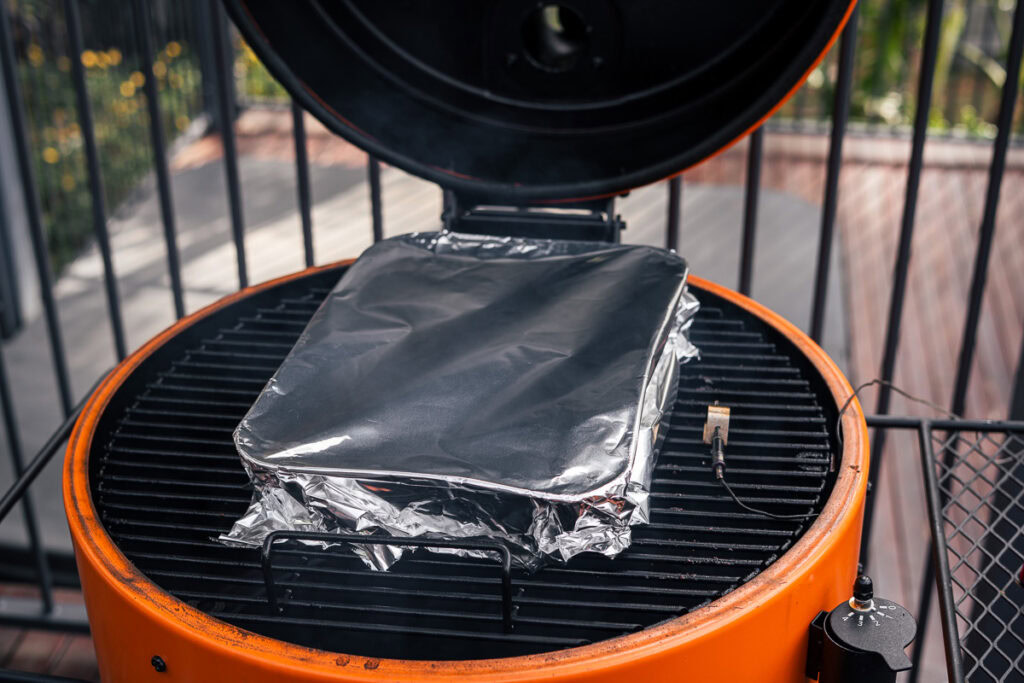
After smoking for a further two hours, start probing until the internal temperature of the meat is around 200-205°F and the probe slides in and out without any resistance.
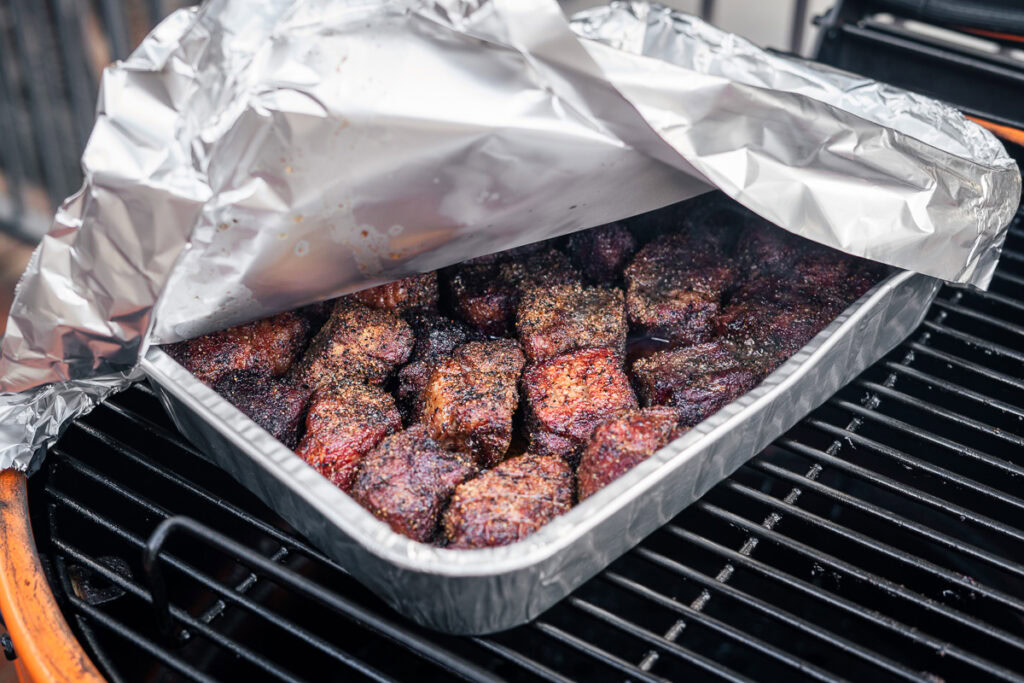
6. Finishing off
You know the burnt ends are done when they feel squishy and can be pushed apart with some pressure. They shouldn’t completely fall apart in your hand, though. You don’t want to overcook them as it will dry the meat out and change the texture.
After the foil is opened and you know the meat is done, it’s time for the finishing touch.
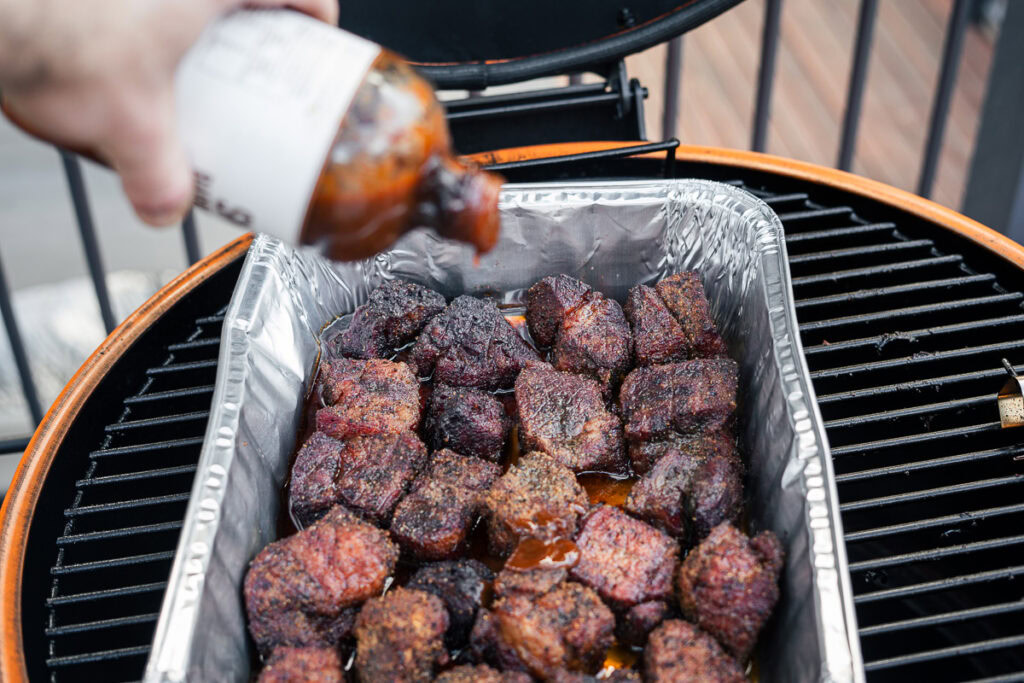
I like to add a little barbecue sauce and mix everything together. Use your favorite store-bought sauce, or try our homemade bbq sauce recipe. If I’m feeling lazy, I’m partial to Lilly’s Q Smoky Barbecue Sauce.
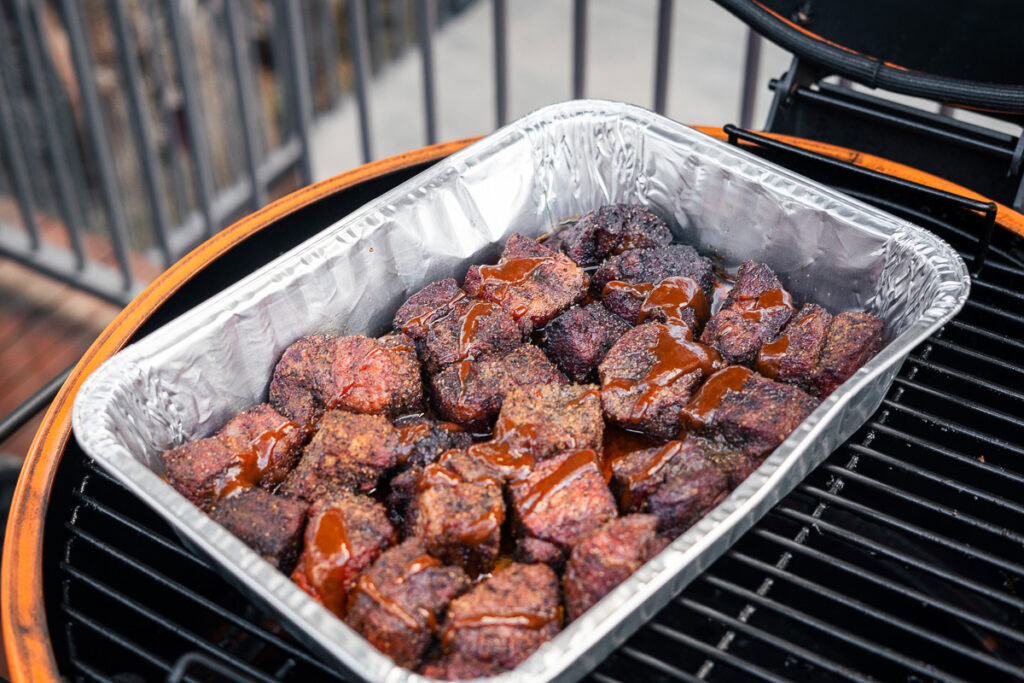
After adding the BBQ sauce, put the foil pan back on the smoker with the foil off for 20-30 minutes until the sauce is nice and tacky.
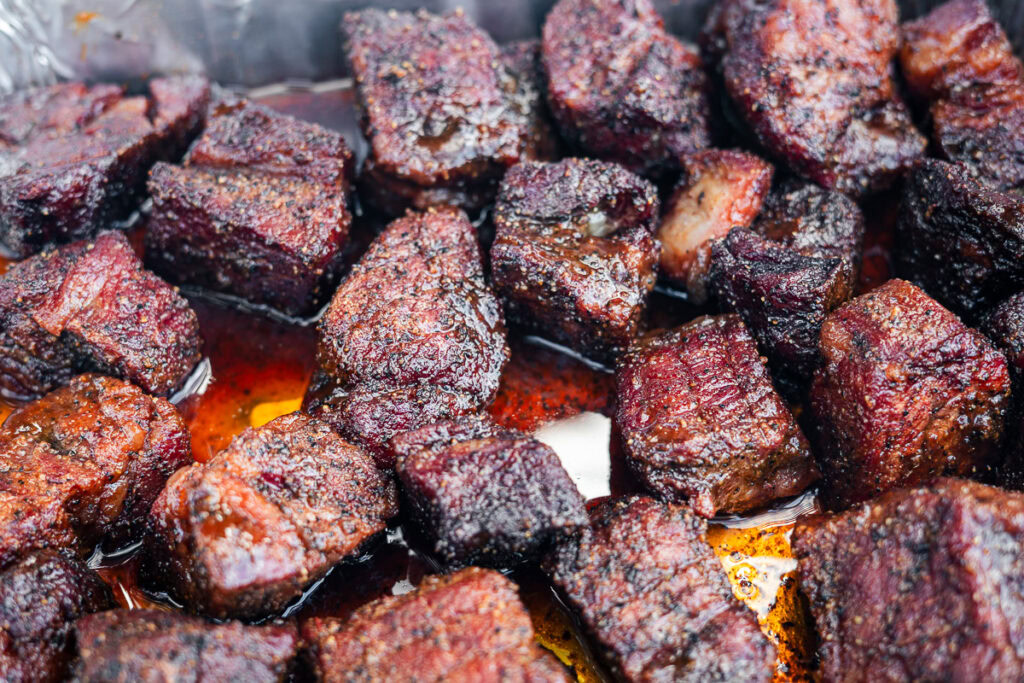
I don’t worry about resting the burnt ends for long, but if you need some extra time, place the foil sheet back over the pan while you finish off your sides.
My favorite way to serve these is in a big pile with the pan’s liquid drizzled over the top.
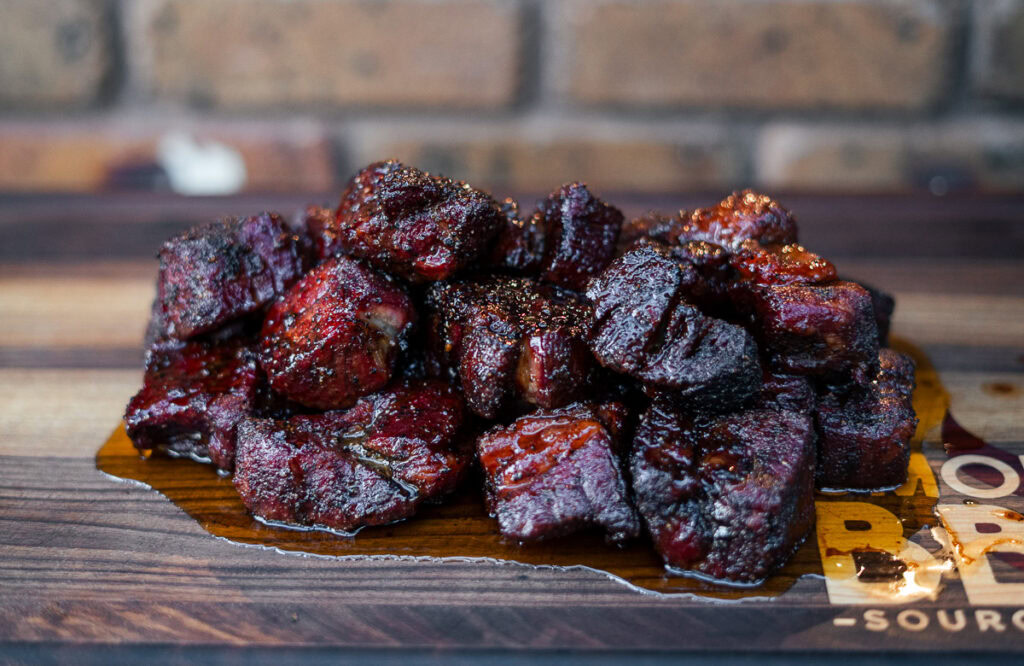
You can also make epic burgers, with a few chunky burnt ends, a pile of coleslaw and another squirt of BBQ sauce.
What to serve with Poor Man’s Burnt Ends
You can serve these poor man’s burnt ends with any of the usual BBQ sides. My personal favorite is a smoked mac and cheese, with some fresh coleslaw to cut through the richness.
You could also go with a creamy potato salad or pasta salad and green beans.
The recipe is really easy to make, delicious and affordable. They may be called poor man’s burnt ends but can taste like a million dollars!
Poor Man’s Burnt Ends Recipe
These poor man’s burnt ends might use chuck roast instead of brisket, but the smoky bark, tender bite, and sticky finish make them every bit as satisfying. Give them a try for your next cookout, and tell us in the comments how many of your guests could tell they weren’t brisket?
If you enjoyed the recipe, please leave a rating too.
Print
Poor Man’s Burnt Ends
Cubes of beefy Chuck roast, seasoned, smoked slowly and sauced for a cheaper version of burnt ends.
Course Appetizer
Cuisine American
Prep Time 20 minutes minutes
Cook Time 6 hours hours
Total Time 6 hours hours 20 minutes minutes
Servings 6
Calories 798kcal
- 5 lbs Chuck roast
- Beef Rub see below for ingredient quantities to make your own beef rub. Aim for 1-1.5 tbsp per pound of chuck.
- 3 tbsp butter unsalted
- 3 tbsp honey see note 1 for more wrap ideas
- ¼ cup Sweet BBQ Sauce Or use our homemade bbq sauce recipe
- Beef broth and water equal quantities for spritzing
Beef Rub
- 1.5 tbsp kosher salt
- 2 tbsp black pepper
- 1.5 tbsp granulated garlic
- 1 tbsp onion powder
- 1 tbsp smoked paprika
Preheat your smoker to 250°F using your favorite smoking wood such as apple, oak, or hickory.
Slice the chuck roast into 1.5–2 inch cubes. Smaller cubes tend to dry out faster. Keep the pieces as even as possible for consistent cooking, but don’t worry if a few end up irregular.
Season the cubes generously on all sides. Use our beef rub recipe, a basic SPG rub or layer in your favorite BBQ rub.
Arrange the cubes evenly on the smoker grate or a wire rack with a little space around each piece so the smoke can circulate. Close the lid and let them smoke undisturbed for 1 hour.
After the first hour, spritz the cubes with a 50/50 mix of beef broth and water. Continue spritzing every 30–45 minutes or whenever the meat starts to look dry.
Smoke the cubes for about 3 hours total, until the bark has set and they are dark and crusty. Internal temperature will usually be between 150–175°F at this point.
Transfer the cubes into a foil pan (or double wrap them in heavy-duty foil). Add a few pads of unsalted butter and a drizzle of honey then cover tightly. To speed things up, you can raise the smoker temperature to 300°F at this stage.
Return the pan to the smoker and cook for another 2 hours, until the cubes are 200–205°F internal and probe tender. A thermometer should slide in with little resistance, and the cubes should feel soft but not fall apart.
Remove the cover, stir in your favorite BBQ sauce, and return the pan to the smoker uncovered for 20–30 minutes. This allows the sauce to reduce slightly and become tacky on the meat.
Serve the burnt ends hot either piled onto a platter with the pan juices poured over the top, or in sandwiches with coleslaw and an extra drizzle of sauce.
1. What to included in the wrap:
-
Butter + honey: Bark stays better; adds richness without flooding liquid.
-
50:50 BBQ sauce + beef broth: Beefier, moister; bark softens a bit.
- BBQ Sauce + Brown Sugar: Too sweet for some, adding sauce earlier does save a little time at the end
2. Update in 2025: This recipe originally called for cutting the chuck roast into 1″ cubes. After further testing, I found that about 1.5–2″ chunks give better results. The extra size helps keep the meat juicy through the long cook, while still giving you plenty of bark and surface area for seasoning. Smaller cubes tend to dry out more quickly, especially during the final stage. Calories: 798kcal | Carbohydrates: 17g | Protein: 73g | Fat: 50g | Saturated Fat: 23g | Trans Fat: 3g | Cholesterol: 276mg | Sodium: 1352mg | Potassium: 1324mg | Fiber: 1g | Sugar: 13g | Vitamin A: 380IU | Vitamin C: 1mg | Calcium: 120mg | Iron: 10mg
Did you miss our previous article...
https://manstuffnews.com/backyard-grilling/the-best-smoked-buffalo-hot-wings-with-crispy-skin
 Backyard GrillingWeekend WarriorsAdvice from DadBeard GroomingTV Shows for Guys4x4 Off-Road CarsMens FashionSports NewsAncient Archeology World NewsPrivacy PolicyTerms And Conditions
Backyard GrillingWeekend WarriorsAdvice from DadBeard GroomingTV Shows for Guys4x4 Off-Road CarsMens FashionSports NewsAncient Archeology World NewsPrivacy PolicyTerms And Conditions
